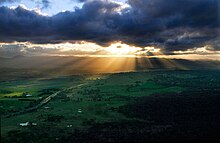From Wikipedia, the free encyclopedia that anyone can edit
Jump to: navigation, search
This article does not cite any references or sources.
Please help improve this article by adding citations to reliable sources. Unsourced material may be challenged and removed. (October 2008)
Crepuscular rays (pronounced /krɪˈpʌskjələr/), in atmospheric optics, are rays of sunlight that appear to radiate from a single point in the sky. These rays, which stream through gaps in clouds or between other objects, are columns of sunlit air separated by darker cloud-shadowed regions. The name comes from their frequent occurrences during crepuscular hours (those around dawn and dusk), when the contrasts between light and dark are the most obvious.
Contents
[edit] Appearance
Crepuscular rays are near-parallel, but appear to diverge because of linear perspective. They often occur when objects such as mountain peaks or clouds partially shadow the sun's rays like a cloud cover. Various airborne compounds scatter the sunlight and make these rays visible, due to diffraction, reflection, and scattering.
Crepuscular rays can also occasionally be viewed underwater, particularly in arctic areas, appearing from ice shelves or cracks in the ice.
There are three primary forms of crepuscular rays[citation needed]:
- Rays of light penetrating holes in low clouds (also called "Jacob's Ladder").
- Beams of light diverging from behind a cloud.
- Pale, pinkish or reddish rays that radiate from below the horizon. These are often mistaken for light pillars.
They are most common in Antarctica.
[edit] Anticrepuscular rays
Crepuscular and anticrepuscular rays are generated in the same way. The rays in some cases may extend across the sky and appear to converge at the antisolar point, which is the point on the sky sphere directly opposite the sun, and they are called anticrepuscular rays. Like crepuscular rays, they are parallel shafts of sunlight from holes in the clouds, and their apparent convergence is a perspective effect.
[edit] Color
Crepuscular rays are usually red or yellow in appearance because the path through the atmosphere at sunrise and sunset pass through up to 40 times as much air as rays from a high midday sun. Particles in the air scatter short wavelength light (blue and green) through Rayleigh scattering much more strongly than longer wavelength yellow and red light.
[edit] Alternative names
- Sunbeams
- Sunburst
- Sun rays[citation needed]
- Sun drawing water - from the ancient Greek belief that sunbeams drew water into the sky (an early description of evaporation)
- Backstays of the sun - a nautical term, from the fact that backstays that brace the mast of a sailing ship converge in a similar way
- Ropes of Maui - (originally. taura a Maui) from the Maori tale of Maui Potiki restraining the sun with ropes to make the days longer
- Jacob's Ladder
- Gateways to Heaven, Stairways to Heaven and Paths to Heaven[citation needed]
- God Rays[citation needed]
- Cloud breaks
- Fingers of God (or God's Fingers)
- Volumetric lighting (used by the computer graphics industry)
- Jesus Beams
- Beams of Jesus
[edit] See also
[edit] References
[edit] External links
Media related to Crepuscular rays at Wikimedia Commons
- Sunrays - Crepuscular rays, Explanation & Images
- detailed description of how Crepuscular rays occur
Retrieved from "http://en.wikipedia.org/wiki/Crepuscular_rays"
2010-05-12
Crepuscular rays - Wikipedia, the free encyclopedia
via en.wikipedia.org







